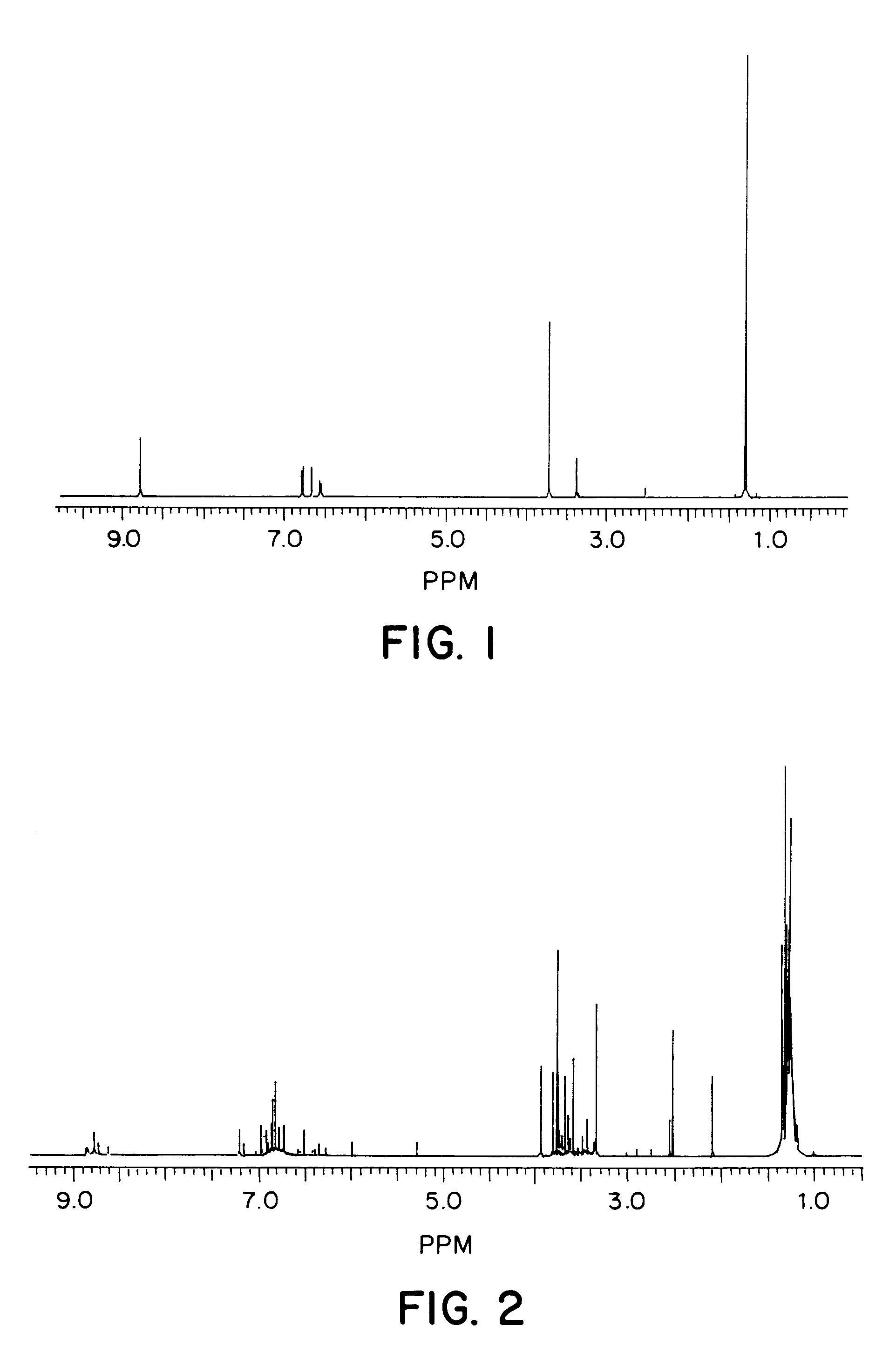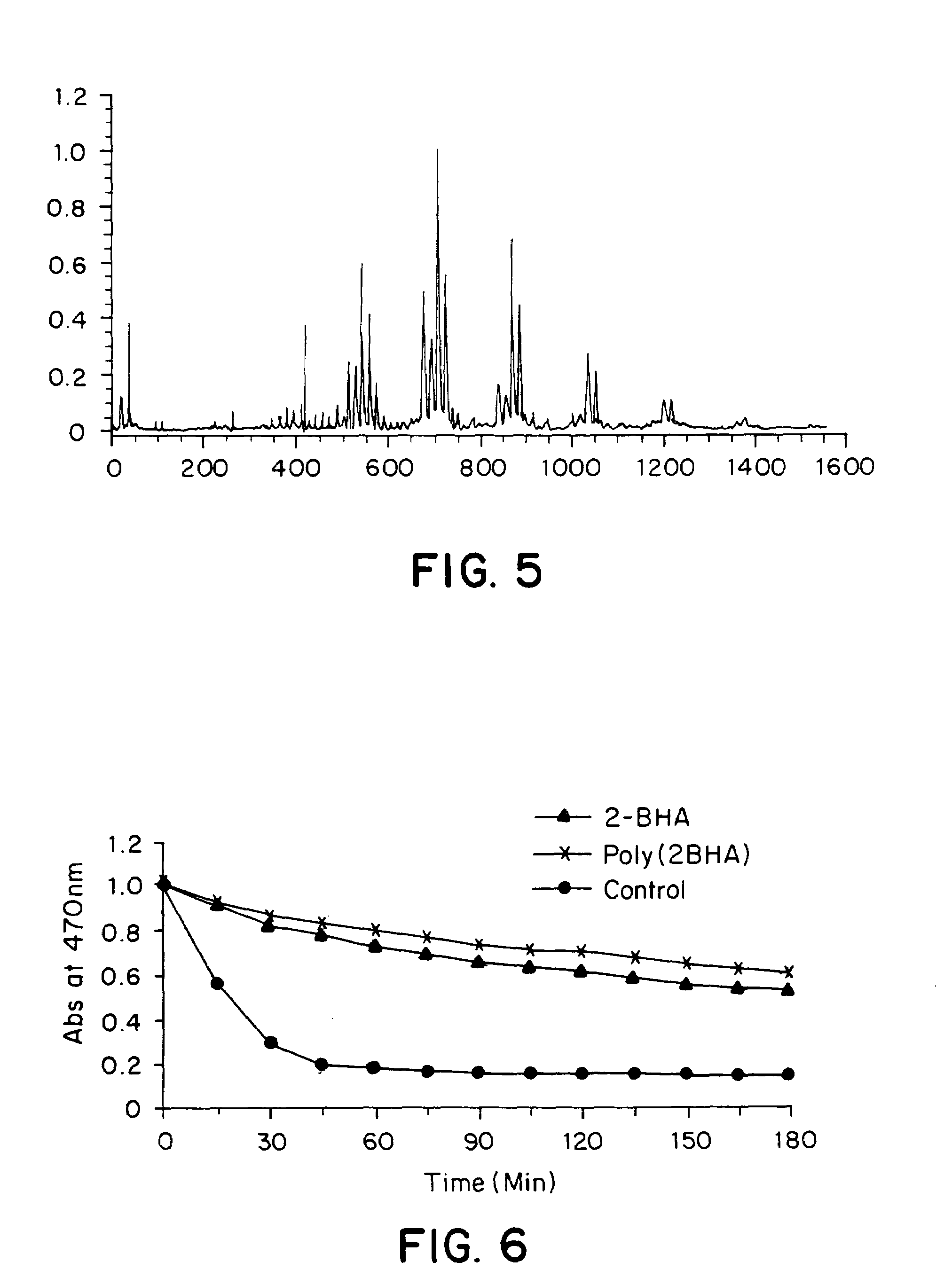Polymeric antioxidants
a technology of polymer antioxidants and antioxidants, applied in the field of polymer antioxidants, can solve the problems of complex chemical changes in the lipids, loss of antioxidant activity of these compounds, and lipids susceptible to oxidation, and achieve the effects of less toxic or toxic, and less toxic or toxic
- Summary
- Abstract
- Description
- Claims
- Application Information
AI Technical Summary
Benefits of technology
Problems solved by technology
Method used
Image
Examples
example 1
Preparation of poly(2-tert-butyl-4-hydroxyanisole)
[0084]Horseradish peroxidase-catalyzed polymerization of 2-tert-butyl-4-hydroxyanisole (2-BHA) was carried out according to the procedure of Holland, H. L. , in Organic Synthesis with Oxidative Enzymes, VCH Publishers, Inc., 1992, the contents of which are incorporated herein by reference. Briefly, 2-BHA (100 mg, 0.56 mmol) was added to a 1:1 (v / v, 6 mL) solution of methanol and 0.01 M sodium phosphate buffer (pH 7), along with horseradish peroxidase, at room temperature. The polymerization was initiated by incremental addition of a stoichiometric amount of hydrogen peroxide (5% aqueous solution, 35 microliters, 0.56 mmol) over a period of 3 hours. After complete addition of the hydrogen peroxide, the reaction was allowed to continue for another 24 hours. The solvent was evaporated by freeze-drying. The polymer was washed thoroughly with aqueous methanol (1:1 v / v) to remove the enzyme and phosphate salts, followed by drying under vac...
example 2
Preparation of Poly(tert-butyl-hydroxyquinone)
[0086]Poly(tert-butyl-hydroxyquinone) was prepared by a variation of the method described in Example 1. The distribution of molecular weights observed in the MALDI-TOF-MS spectrum (FIG. 5) confirms formation of a polymer.
example 3
Comparison of Antioxidant Activity of Monomers Versus Polymers
[0087]The antioxidant activity of monomers and enzymatically-prepared polymeric antioxidants was compared by measuring the bleaching of a beta-carotene system. In the model system, beta-carotene undergoes rapid discoloration in the absence of an antioxidant. The assay and measurements were conducted according to the procedure described in Jayaprakasha, G. K. , et al. Food Chemistry 73: 285-290 (2001) and Hidalgo, M. E., et al Phytochemistry 37: 1585-1587 (1994), the contents of which are incorporated herein by reference. Briefly, beta-carotene (0.2 mg), linoleic acid (20 mg), and 200 mg of Tween-40 (polyoxyethylene sorbitan monopalmitate) were dissolved in 0.5 mL of chloroform. The chloroform was removed under vacuum and the resulting mixture was immediately diluted with 10 mL of distilled water and mixed well for 1-2 minutes. The resulting emulsion was further made up to 50 mL with oxygenated water. Aliquots (4 mL) of th...
PUM
| Property | Measurement | Unit |
|---|---|---|
| pH | aaaaa | aaaaa |
| pH | aaaaa | aaaaa |
| pH | aaaaa | aaaaa |
Abstract
Description
Claims
Application Information
 Login to View More
Login to View More - R&D
- Intellectual Property
- Life Sciences
- Materials
- Tech Scout
- Unparalleled Data Quality
- Higher Quality Content
- 60% Fewer Hallucinations
Browse by: Latest US Patents, China's latest patents, Technical Efficacy Thesaurus, Application Domain, Technology Topic, Popular Technical Reports.
© 2025 PatSnap. All rights reserved.Legal|Privacy policy|Modern Slavery Act Transparency Statement|Sitemap|About US| Contact US: help@patsnap.com



